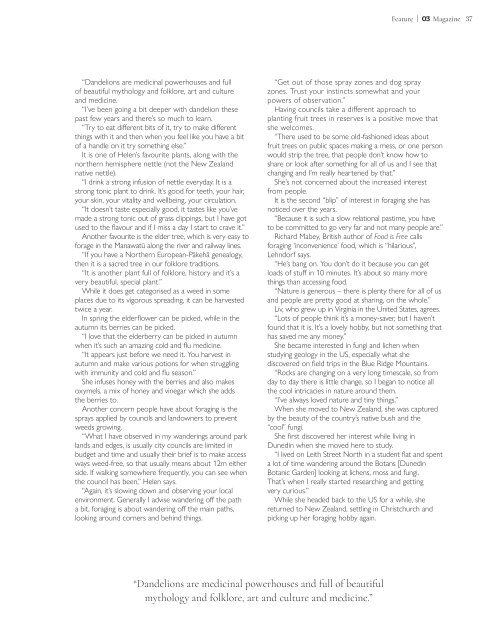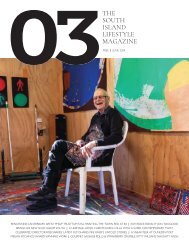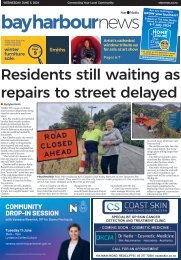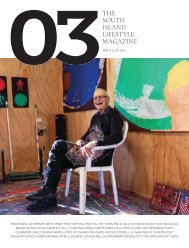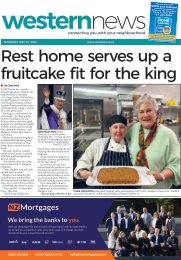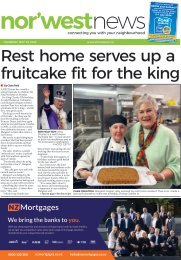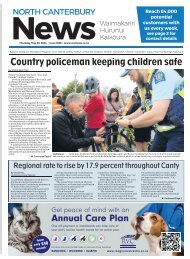Create successful ePaper yourself
Turn your PDF publications into a flip-book with our unique Google optimized e-Paper software.
Feature | <strong>Magazine</strong> 37<br />
“Dandelions are medicinal powerhouses and full<br />
of beautiful mythology and folklore, art and culture<br />
and medicine.<br />
“I’ve been going a bit deeper with dandelion these<br />
past few years and there’s so much to learn.<br />
“Try to eat different bits of it, try to make different<br />
things with it and then when you feel like you have a bit<br />
of a handle on it try something else.”<br />
It is one of Helen’s favourite plants, along with the<br />
northern hemisphere nettle (not the New Zealand<br />
native nettle).<br />
“I drink a strong infusion of nettle everyday. It is a<br />
strong tonic plant to drink. It’s good for teeth, your hair,<br />
your skin, your vitality and wellbeing, your circulation.<br />
“It doesn’t taste especially good, it tastes like you’ve<br />
made a strong tonic out of grass clippings, but I have got<br />
used to the flavour and if I miss a day I start to crave it.”<br />
Another favourite is the elder tree, which is very easy to<br />
forage in the Manawatū along the river and railway lines.<br />
“If you have a Northern European-Pākehā genealogy,<br />
then it is a sacred tree in our folklore traditions.<br />
“It is another plant full of folklore, history and it’s a<br />
very beautiful, special plant.”<br />
While it does get categorised as a weed in some<br />
places due to its vigorous spreading, it can be harvested<br />
twice a year.<br />
In spring the elderflower can be picked, while in the<br />
autumn its berries can be picked.<br />
“I love that the elderberry can be picked in autumn<br />
when it’s such an amazing cold and flu medicine.<br />
“It appears just before we need it. You harvest in<br />
autumn and make various potions for when struggling<br />
with immunity and cold and flu season.”<br />
She infuses honey with the berries and also makes<br />
oxymels, a mix of honey and vinegar which she adds<br />
the berries to.<br />
Another concern people have about foraging is the<br />
sprays applied by councils and landowners to prevent<br />
weeds growing.<br />
“What I have observed in my wanderings around park<br />
lands and edges, is usually city councils are limited in<br />
budget and time and usually their brief is to make access<br />
ways weed-free, so that usually means about 12m either<br />
side. If walking somewhere frequently, you can see when<br />
the council has been,” Helen says.<br />
“Again, it’s slowing down and observing your local<br />
environment. Generally I advise wandering off the path<br />
a bit, foraging is about wandering off the main paths,<br />
looking around corners and behind things.<br />
“Get out of those spray zones and dog spray<br />
zones. Trust your instincts somewhat and your<br />
powers of observation.”<br />
Having councils take a different approach to<br />
planting fruit trees in reserves is a positive move that<br />
she welcomes.<br />
“There used to be some old-fashioned ideas about<br />
fruit trees on public spaces making a mess, or one person<br />
would strip the tree, that people don’t know how to<br />
share or look after something for all of us and I see that<br />
changing and I’m really heartened by that.”<br />
She’s not concerned about the increased interest<br />
from people.<br />
It is the second “blip” of interest in foraging she has<br />
noticed over the years.<br />
“Because it is such a slow relational pastime, you have<br />
to be committed to go very far and not many people are.”<br />
Richard Mabey, British author of Food is Free calls<br />
foraging ‘inconvenience’ food, which is “hilarious”,<br />
Lehndorf says.<br />
“He’s bang on. You don’t do it because you can get<br />
loads of stuff in 10 minutes. It’s about so many more<br />
things than accessing food.<br />
“Nature is generous – there is plenty there for all of us<br />
and people are pretty good at sharing, on the whole.”<br />
Liv, who grew up in Virginia in the United States, agrees.<br />
“Lots of people think it’s a money-saver, but I haven’t<br />
found that it is. It’s a lovely hobby, but not something that<br />
has saved me any money.”<br />
She became interested in fungi and lichen when<br />
studying geology in the US, especially what she<br />
discovered on field trips in the Blue Ridge Mountains.<br />
“Rocks are changing on a very long timescale, so from<br />
day to day there is little change, so I began to notice all<br />
the cool intricacies in nature around them.<br />
“I’ve always loved nature and tiny things.”<br />
When she moved to New Zealand, she was captured<br />
by the beauty of the country’s native bush and the<br />
“cool” fungi.<br />
She first discovered her interest while living in<br />
Dunedin when she moved here to study.<br />
“I lived on Leith Street North in a student flat and spent<br />
a lot of time wandering around the Botans [Dunedin<br />
Botanic Garden] looking at lichens, moss and fungi.<br />
That’s when I really started researching and getting<br />
very curious.”<br />
While she headed back to the US for a while, she<br />
returned to New Zealand, settling in Christchurch and<br />
picking up her foraging hobby again.<br />
“Dandelions are medicinal powerhouses and full of beautiful<br />
mythology and folklore, art and culture and medicine.”


